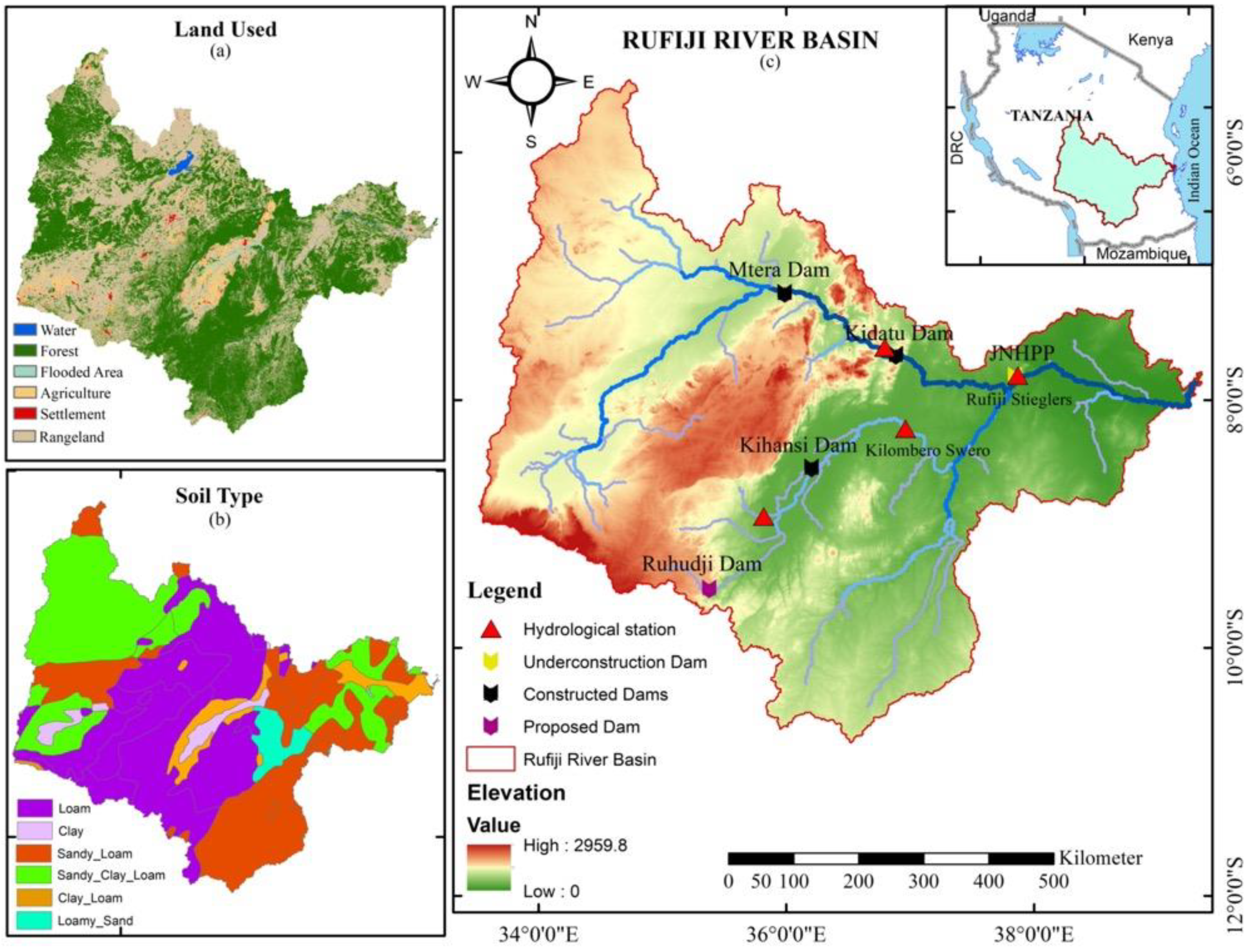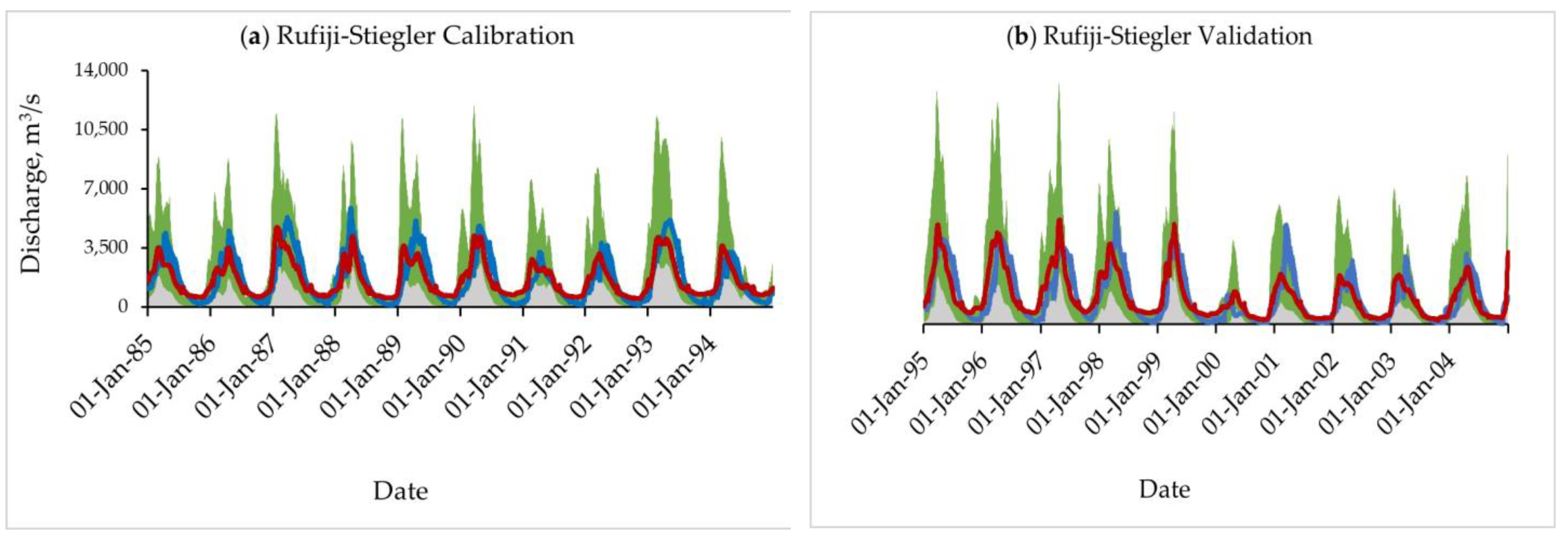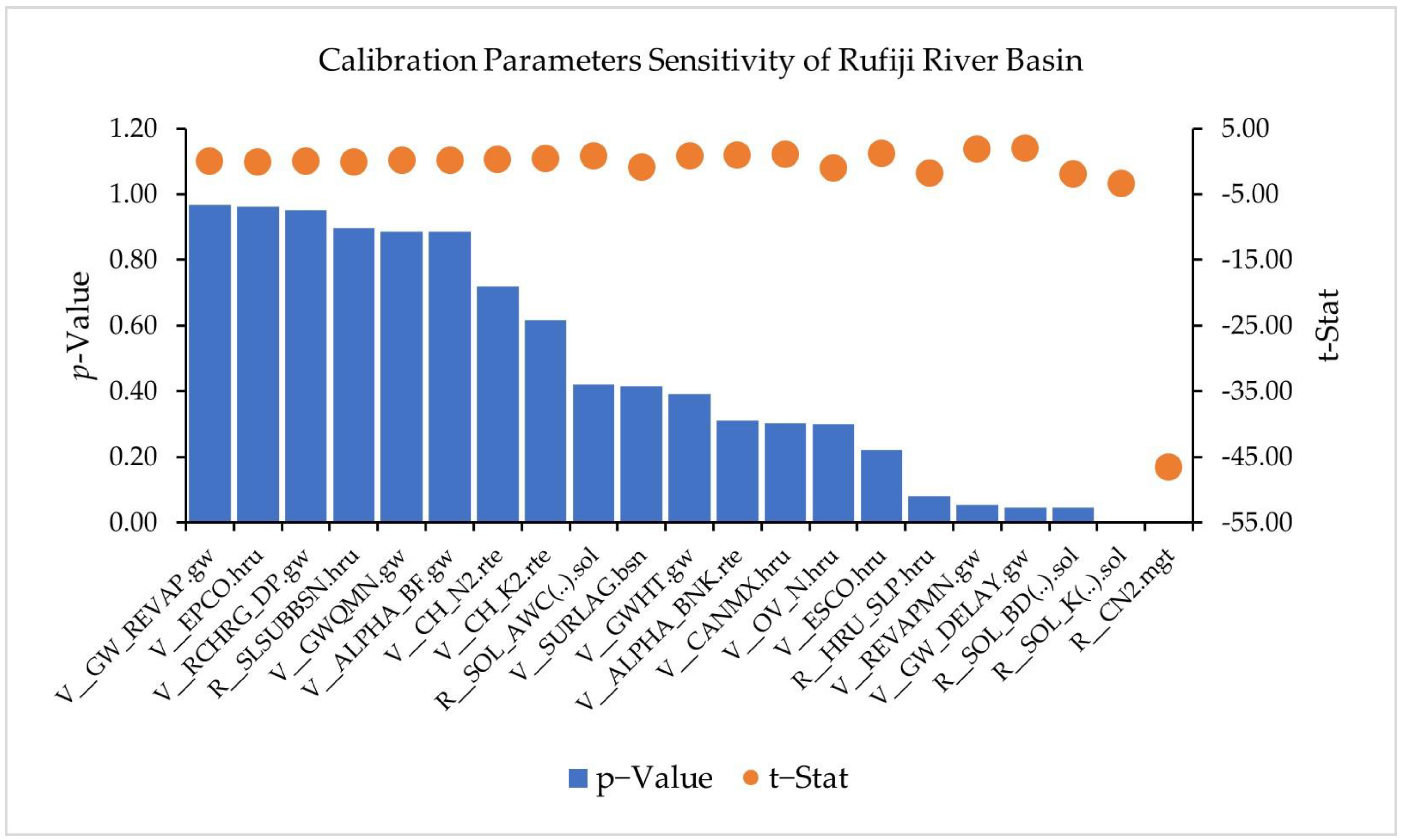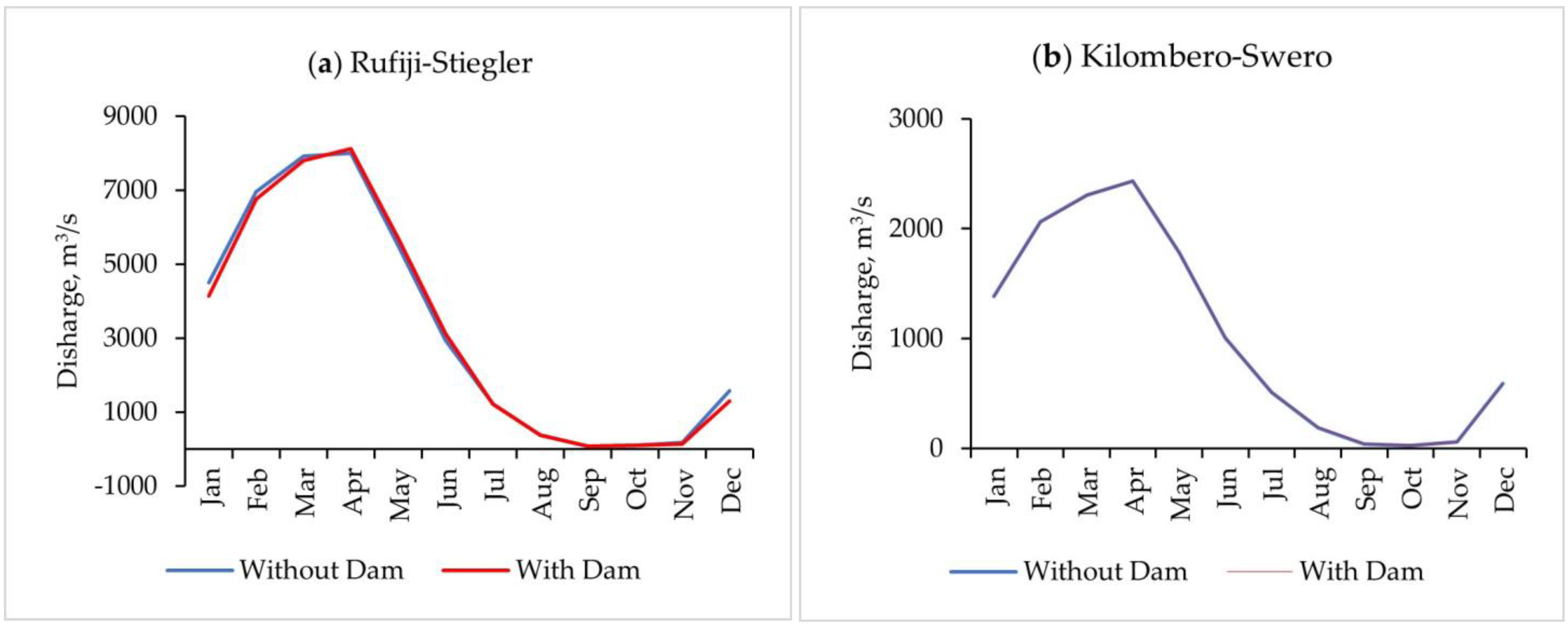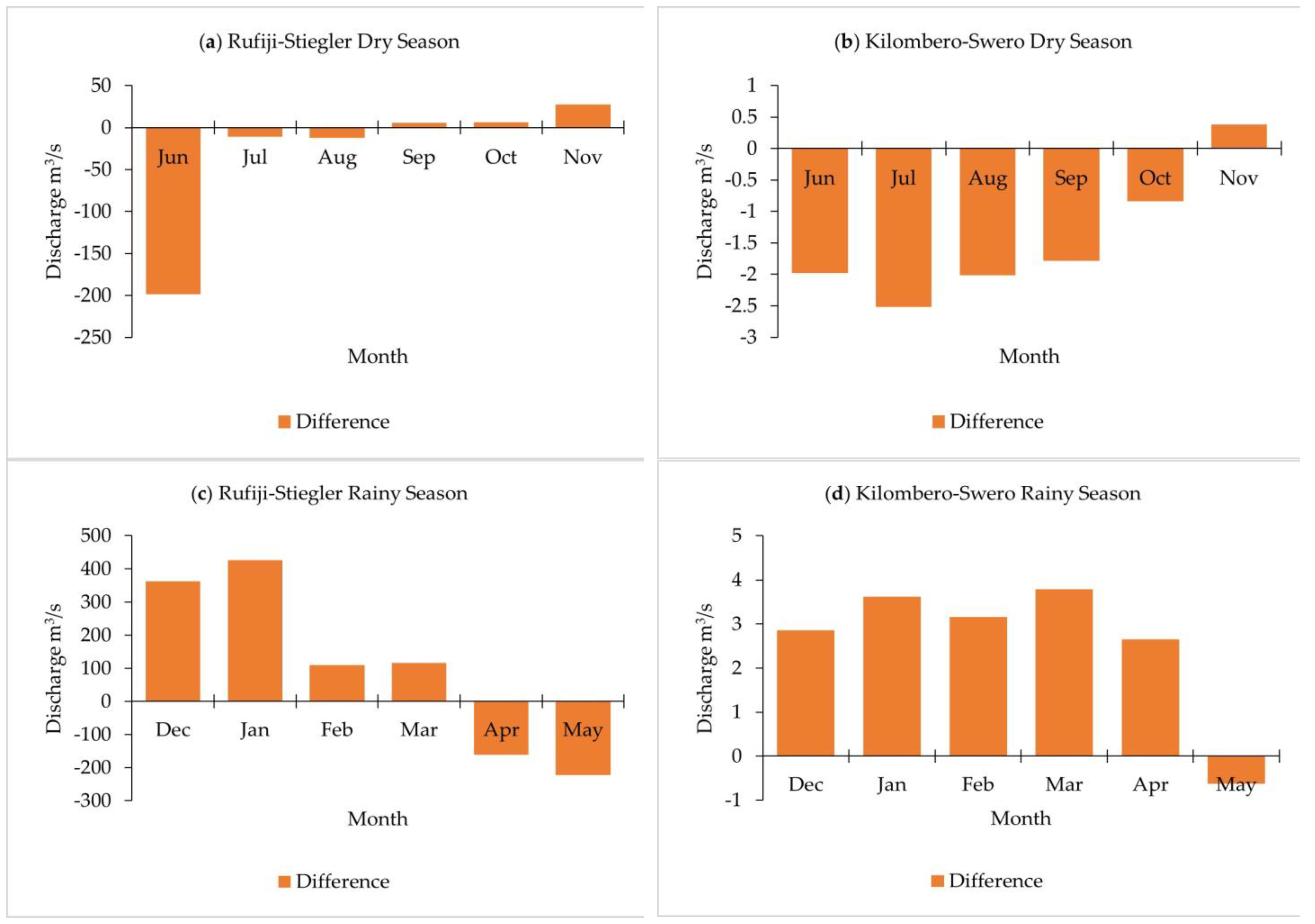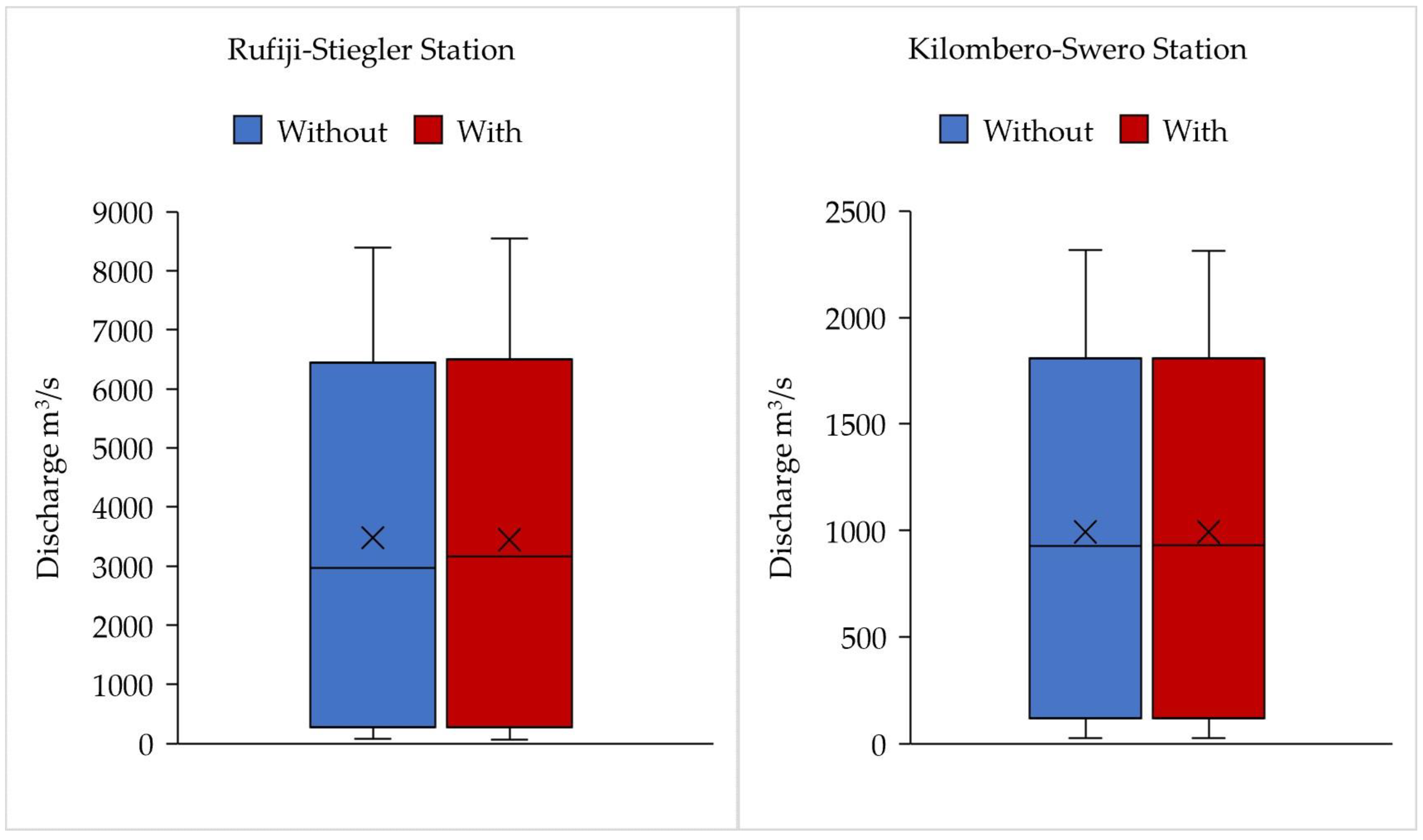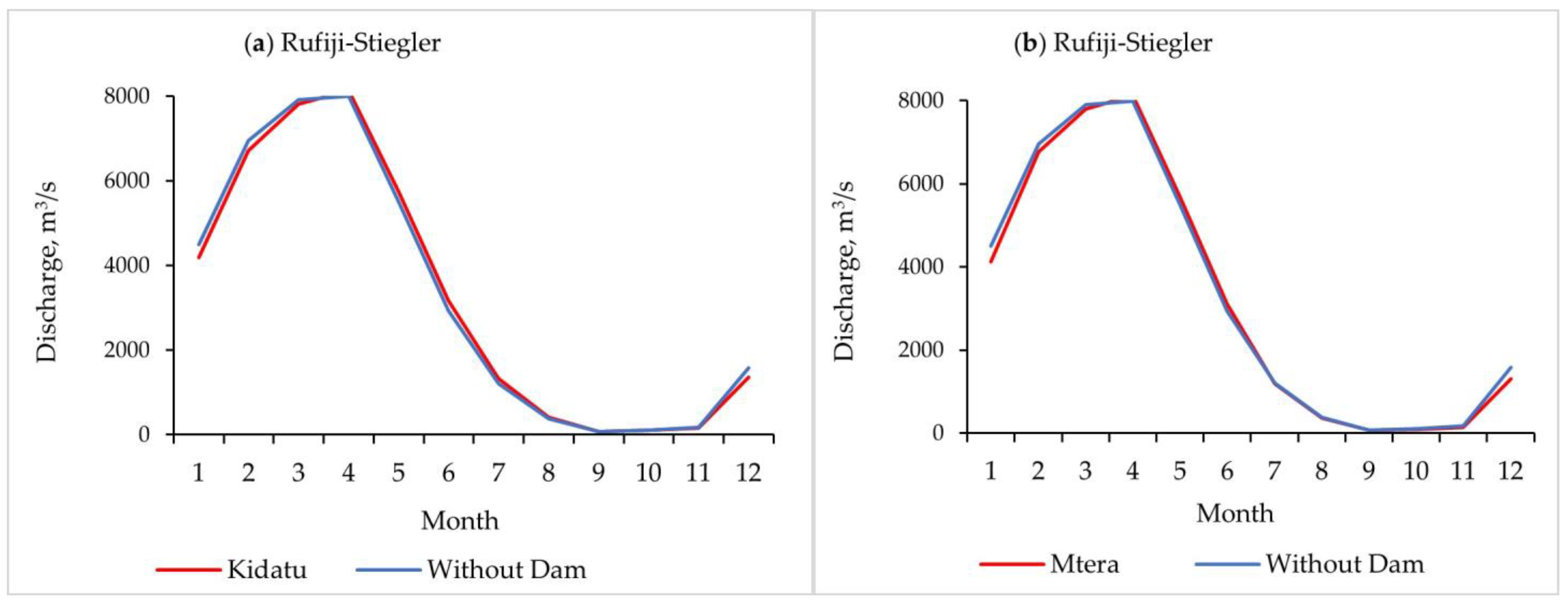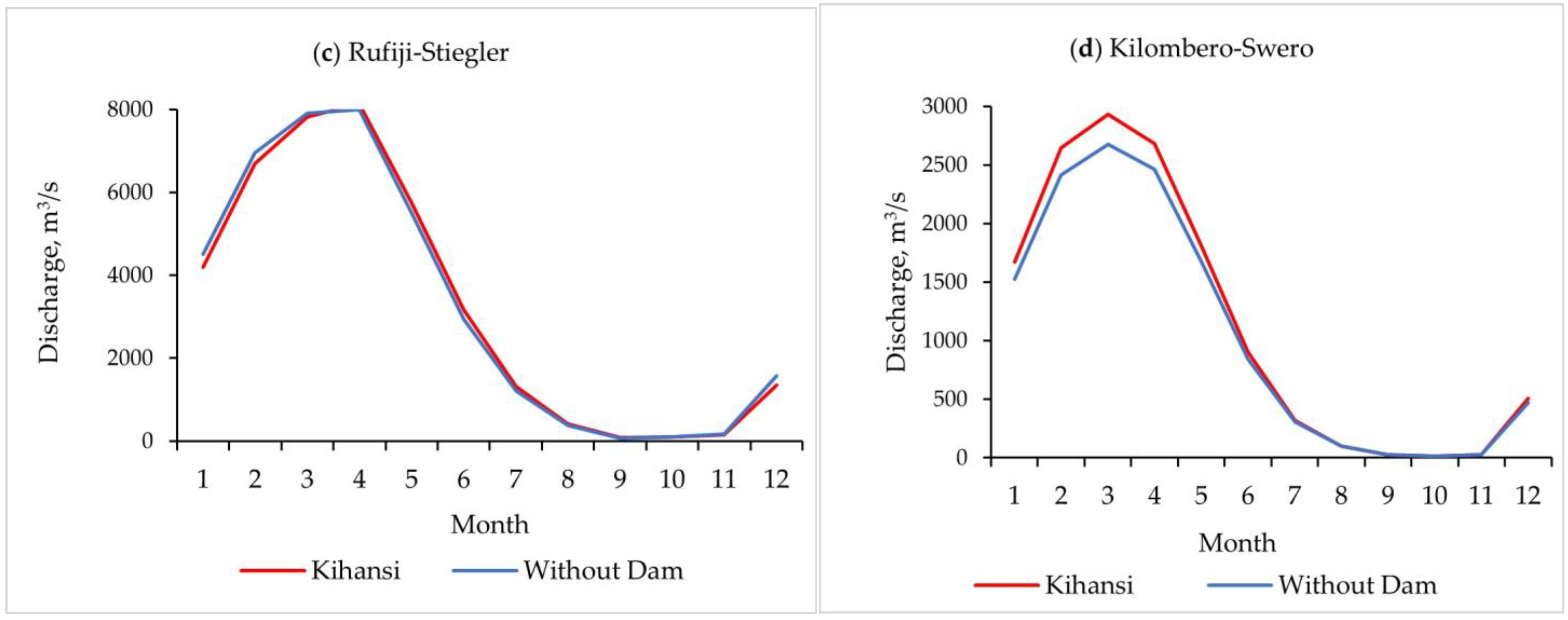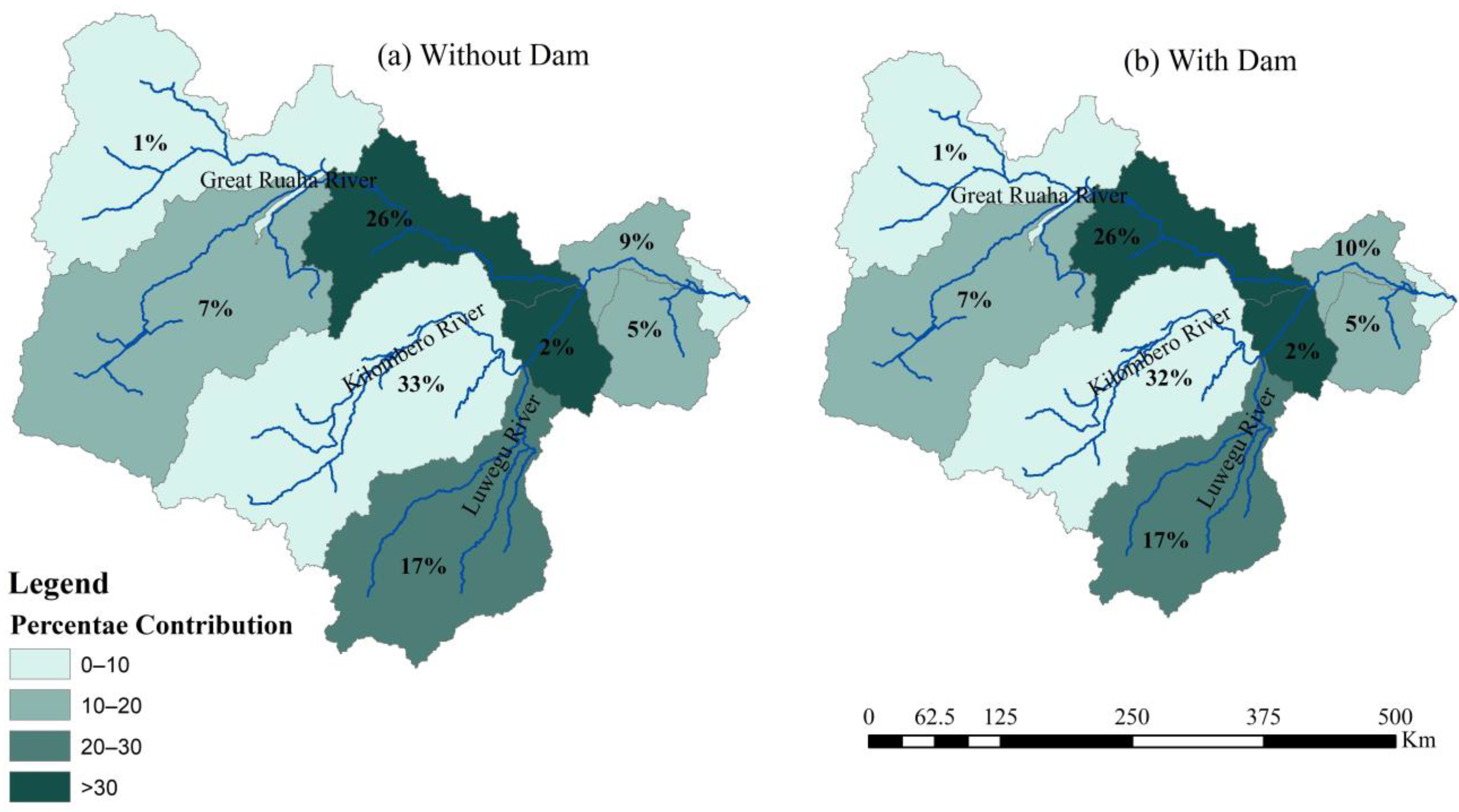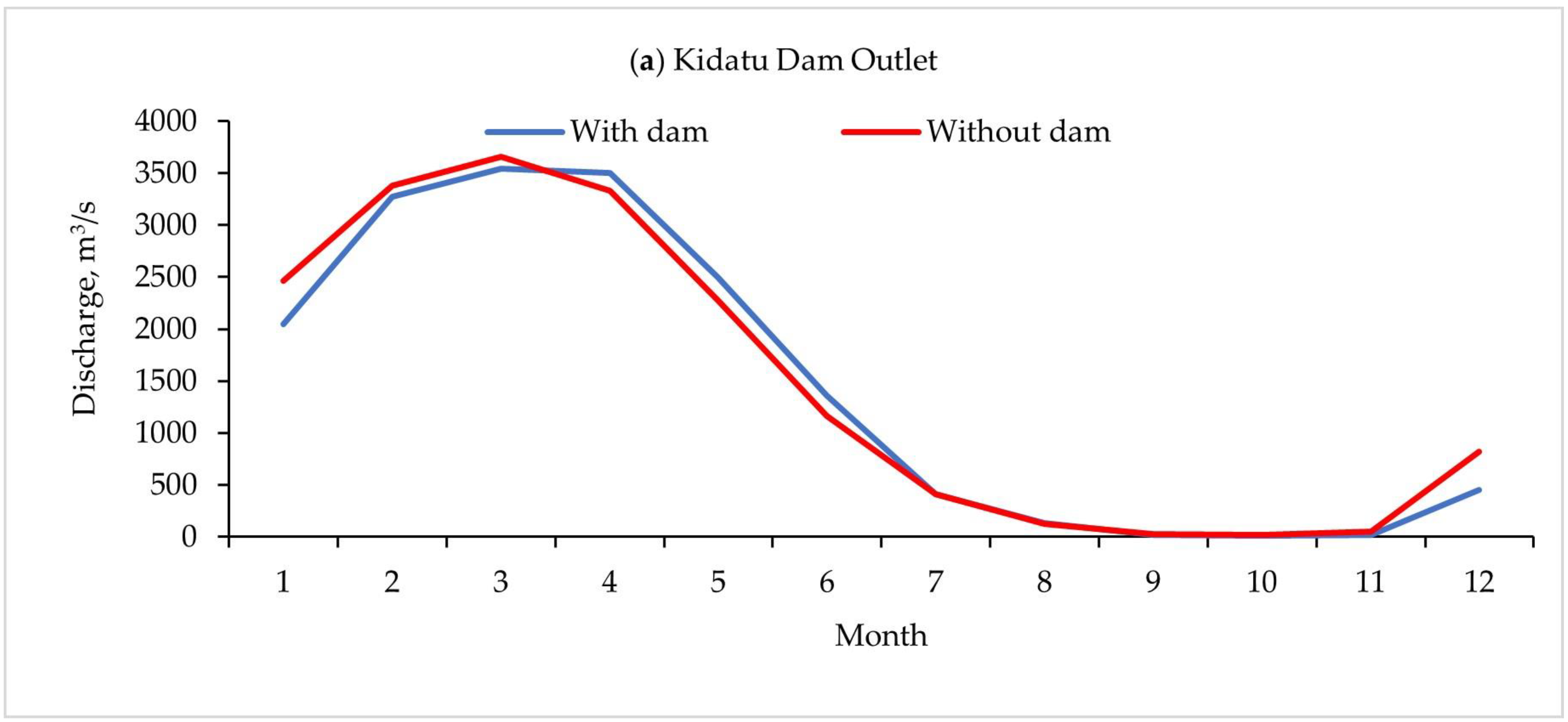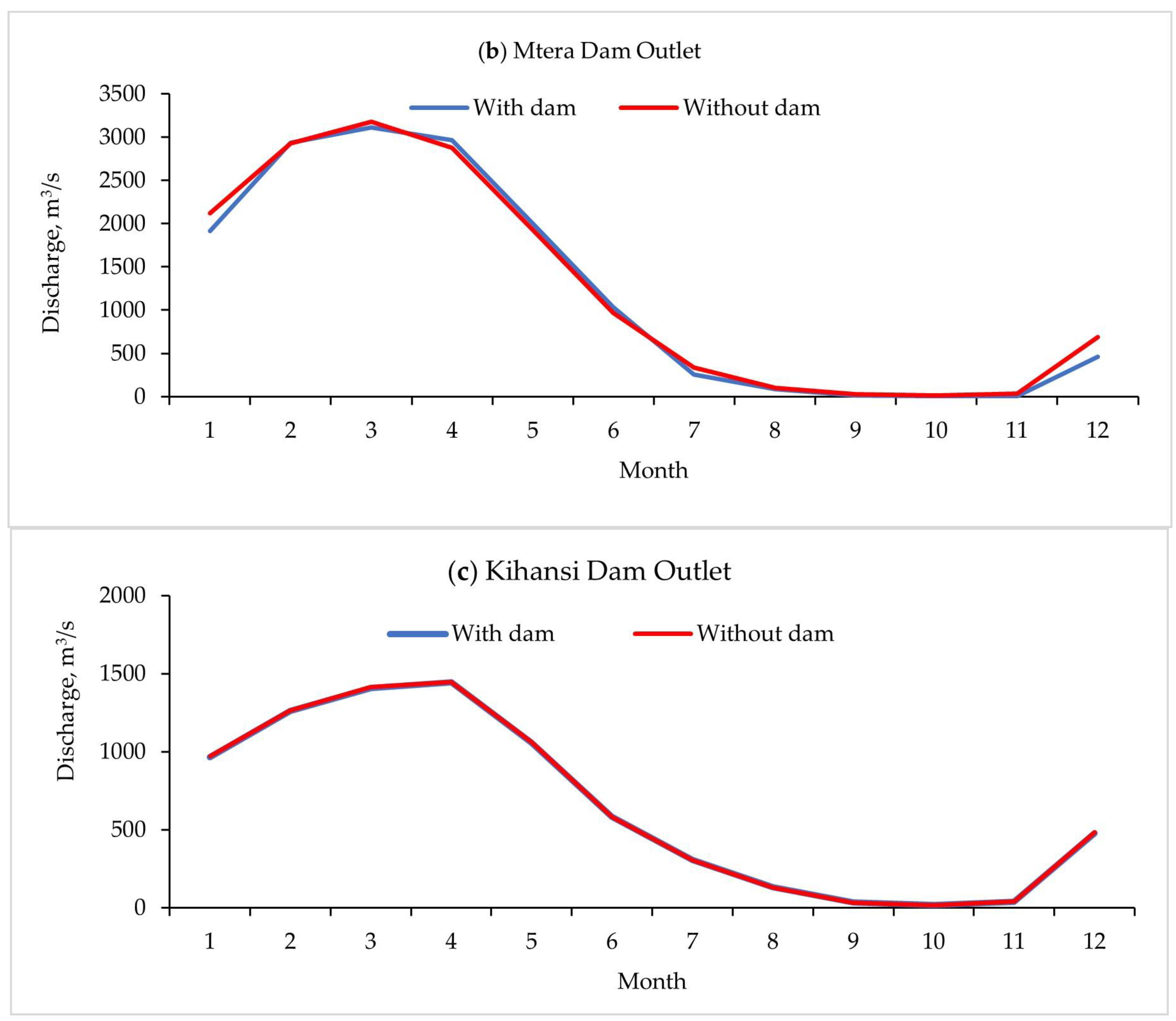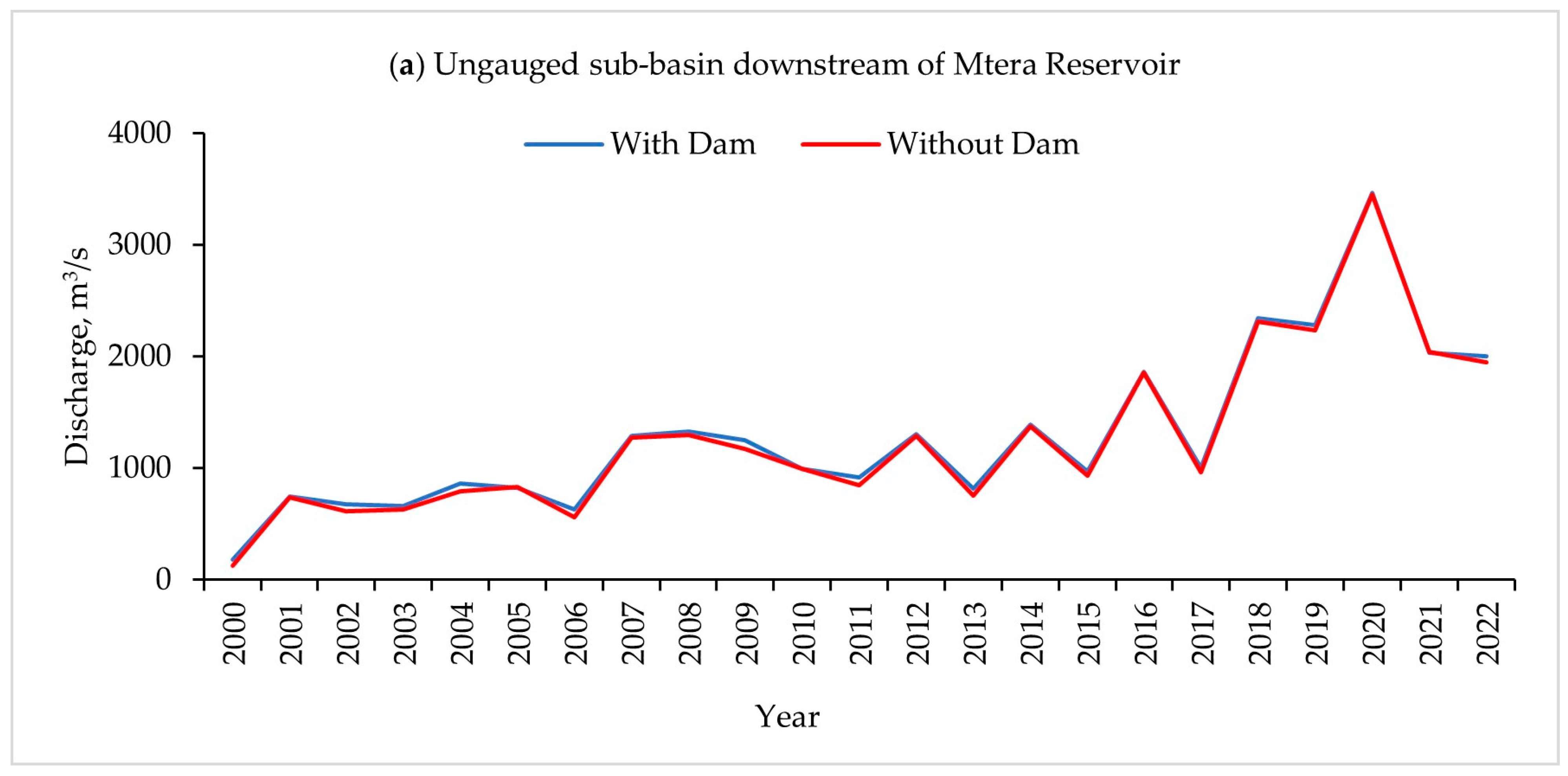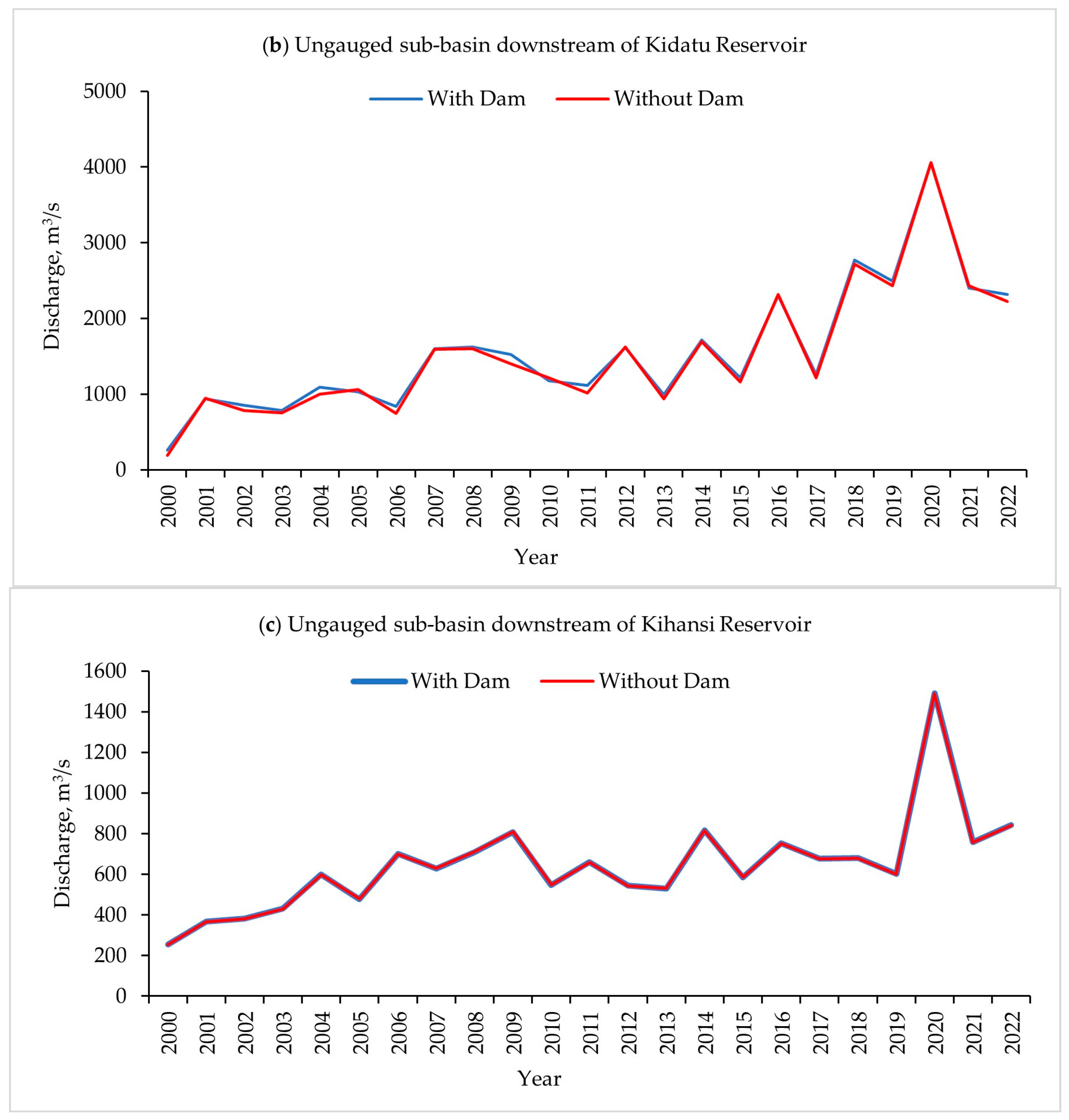1. Introduction
The construction and operation of dams play a crucial role in meeting the growing demands for water resources, flood control, and energy production globally [
1,
2,
3]. However, the extensive development of dam infrastructure can significantly alter the natural dynamics of river systems, impacting downstream ecosystems and hydrological processes [
4,
5,
6].
The Rufiji River Basin is Tanzania’s largest of nine river basins. It is the most crucial water resource and is vital to the country’s economy. The Rufiji River Basin produces half of Tanzania’s river flow and provides water for several applications. This includes providing 4.5 million people with household water needs, water for cattle and irrigation, and using water to generate around 80% of the nation’s hydropower (or about 47% of the total installed electricity generating capacity of the nation) [
7]. The strategic placement of the Mtera, Kihansi, and Kidatu Dams along the river has aimed to harness the hydropower potential, regulate streamflow for irrigation, and provide flood control [
8,
9]. However, as with any large-scale infrastructure, these interventions have raised concerns about their environmental and hydrological impacts on the downstream reaches of the Rufiji River. The growing demand for electricity and water resources has necessitated the establishment of a series of cascading dams along the Rufiji River. Kidatu Dam, operational since 1980, was followed by Mtera Dam and Kihansi Dam, commissioned in 1980 and 2000, respectively. These dams, operating in tandem, have formed an integrated system influencing the hydrology of the Rufiji River and its downstream areas. Understanding the cumulative impacts of these cascading dams is crucial for effective water resource management, environmental conservation, and sustainable energy production in the region [
10,
11,
12].
Traditional methods including streamflow time-series studies and analyses of runoff–climate relationships have been employed to understand the anthropogenic effects on streamflow, providing initial insights into hydrological systems. However, these methods may struggle to capture the nonlinear nature of hydrological systems. To address this, hydrological models are used for reconstruction, allowing several simulation scenarios such without-dam and with-dam. They further enable the evaluation of the impacts of cascading dams into the river system [
13,
14].
This study used a promising paradigm that integrates reservoir operation with hydrological models. In particular, the semi-distributive hydrological model SWAT, which effectively combines basic reservoir management principles with basin hydrological parameters, proved essential in estimating the effect cascading dams have on streamflow. Through this comprehensive model, the research achieved quantification of the distinct contributions of each dam group to alterations in downstream flow. Additionally, it assessed the specific impact of each sub-basin on the downstream flow discharge.
Numerous research endeavors have employed numerical models to examine the hydrological patterns of the entire Rufiji River Basin and its sub-catchments. Existing studies have explored specific aspects such as land use changes, water balance, and climate variability [
8,
15,
16]. However, there is a gap in our understanding of how these factors interact and contribute to the overall impact of cascading dams on downstream streamflow. Additionally, current research predominantly focuses on individual sub-catchments or watersheds within the Rufiji River Basin, lacking comprehensive studies that encompass the entire basin and consider the interconnectedness of different sub-catchments in the context of cascading dams.
The study aims to provide a comprehensive analysis of the impacts of the cascading dams, Mtera, Kihansi, and Kidatu, on the downstream areas of the Rufiji River Basin. The SWAT model was employed to simulate the streamflow from 1982 to 2022 and the effect of cascading dams on streamflow. The specific objectives of the study were to: (1) analyze the alterations in streamflow patterns downstream of the cascading dams during various hydrological conditions, including dry and rainy seasons, and (2) quantify the contribution of sub-basins. Understanding the multifaceted impacts of cascading dams in the Rufiji River Basin is essential for informed decision-making in water resource management and environmental conservation. This research contributes valuable insights into the complex interactions between dam infrastructure and downstream ecosystems, with implications for sustainable development and biodiversity conservation.
2. Material and Methods
2.1. Study Area
The Rufiji River Basin is the largest of the nine river basins in Tanzania (
Figure 1). It is found at 7°46′26″ S and 39°21′50″ E. It occupies 20% of Tanzania’s mainland and spreads across 177,420 km
2. The Rufiji River is one of the longest rivers in Africa and is approximately 600 km long. The river lies entirely within Tanzania, starting in the country’s southwest and reaching the Indian Ocean. The Rufiji River Basin is Tanzania’s most economically significant river basin, producing half of the country’s river flow, providing water to 4.5 million people for irrigation and livestock, producing about 80% of the nation’s hydropower, and supporting environmental flows in several major wildlife parks [
7,
9].
The Rufiji River has three major tributaries: the Greater Ruaha (83,970 km
2; 47%), the Kilombero (39,990 km
2; 20%), and the Luwegu Rivers (26,300 km
2; 18%) [
17] (
Table 1). The Rufiji River has a mean annual flow of approximately 800 m
3/s, with the Kilombero River contributing 62% of the Rufiji Basin runoff compared to 18% and 15% of the Great Ruaha and the Luwegu River, respectively. The river displays a noticeable seasonal flow pattern, with its flood peak typically occurring in April. Rice and maize are traditional and commercial plants along its fertile lower flood plain [
18].
Based on the satellite rainfall data collected over 41 years from 1982 to 2022, it is evident that the average annual rainfall in the entire basin exhibits substantial variation. Precisely, for the observed data, the average annual rainfall measured 2743 mm, ranging from a low of 223 mm in the dry lowland regions (Dodoma and Iringa) to a high of 6647 mm in the wet highland regions (Morogoro, Njombe, and Mbeya) (
Figure 2). The rainfall distribution also displayed a seasonal pattern, with approximately 90% of the annual rainfall occurring between November and April. Furthermore, the average temperature within the basin was recorded at 23.1 °C. Notably, the lowest temperatures are experienced during June and July, while the highest is observed from September to November (
Figure 2). In terms of streamflow, it undergoes significant fluctuations across the seasons. The flood season, corresponding to the heaviest rainy period, transpires from February to April.
2.2. Data Processing and Modeling
2.2.1. SWAT Model
The SWAT model is a semi-distributed model. It was developed by the United States Department of Agriculture Research Service (USDA-ARS) and Texas AgriLife Research [
19]. The SWAT model links with different GIS software’s and also works with various tools and interfaces such as Arc SWAT, QSWAT, MWSWAT, R-SWAT, and SWAT-CUP [
20]. The SWAT model splits the watershed into sub-basins. Then, it divides the sub-basins into hydrological response units (HRUs) according to the soil properties, land use, and slope [
21]. This study employed QSWAT3_9 version 1.6 with QGIS 3.28.9 (long-time release).
2.2.2. Input Data
In hydrological modeling, data are constantly used, and they are vital. Both satellite and observed data were used in this study. Available streamflow, rainfall, topography, land use, soil map, and dam data for the entire Rufiji River Basin were collected to set, calibrate, and validate the SWAT model. Observed data were collected from the Rufiji Basin Water Board (RBWB) and Tanzania Electricity Supply Company Ltd. (TANESCO) in Dodoma, Tanzania.
Daily stream flows and reservoir discharge data were gathered from the Rufiji Basin Water Board (RBWB). Daily streamflow data at Rufiji-Stigler’s (1K3B) and Kilombero-Swero (1KB17) stations between 1982 and 2022 were utilized to calibrate and validate the results of the SWAT model (
Table 2 and
Figure 1).
Daily rainfall and temperature satellite data were collected from 8-point locations (similar to existing rain gauge stations) scattered across the Rufiji River Basin between 1982 and 2022 (
Table 3). The study planned to utilize the observed rainfall data. However, due to the discontinuity of the observed rainfall data, the rainfall and temperature data from 1982 to 2022 were downloaded from the NASA Power Data Access Viewer [
22]. The selection of the NASA Power Data Access Viewer was because it aligned with the simulation period defined for the study (1982–2022) compared to other satellite packages. The SWAT weather database simulated relative humidity, solar radiation, and wind speed. The WGEN_US_COOP_1980_2010 with a 16,553 station count weather generator was utilized.
- (iii)
Digital Elevation Model
This research employed a void-filled digital elevation model with a resolution of 3 arc-seconds from the Hydro SHEDS v1 collection (
https://www.hydrosheds.org/hydrosheds-core-downloads) (accessed on 22 June 2023). The DEM was generated by merging data from the Shuttle Radar Topography Mission. The resulting DEM map was formatted as a Type A spatial representation grid and utilized the Universal Transverse Mercator (UTM) zone 37S (WGS 84/UTM zone 37S-EPSG:32737) coordinate system with a reference data date of 2014.
The Rufiji River Basin consists of three operating dams (Mtera, Kidatu, and Kihansi), an under-construction dam (Julius Nyerere Hydroelectric Power Project, JNHPP), and a proposed dam (Ruhudji) (
Figure 1). This study incorporated the three operating reservoirs into the SWAT model. The characteristics of the dams (such as operating rules, volume, water level, water release, and construction year) were collected from the Tanzania Electricity Supply Company (TANESCO) (
Table 4).
2.2.3. SWAT Model Setup
The SWAT model was configured by defining parameters, initial conditions, and simulation duration. The watershed was delineated after drawing and snapping outlets and three reservoirs at a threshold of 300 m. The basin was divided into 63 sub-basins and 568 HRUs. The subbasins were divided into eight land classes, thirty-one soil classes, and five slope classes. The SWAT model simulation spanned 41 years, from 1982 to 2022. The model results were carefully examined and effectively visualized to derive meaningful insights.
2.2.4. Reservoir Setup
The reservoirs were established with specific parameters. The setting of the reservoirs focused on two key parameters: the hydraulic conductivity of the reservoir bottom (RES_K; mm/h), and the number of days required to reach the target storage level from the current reservoir storage (NDTARGR; days). Additionally, other parameters were included such as the month and year the reservoir became operational (MORES and IYRES), the surface area of the reservoir when filled to the emergency spillway (RES-ESA) in hectares, the volume of water required to fill the reservoir to the emergency spillway (EVOL) in units of 10
4 m
3, the surface area of the reservoir when filled to the principal spillway (RES PSA) in hectares, the volume of water needed to fill the reservoir to the principal spillway (RES_PVOL) in units of 10
4 m
3, and the initial reservoir volume (RES_VOL) in units of 10
4 m
3 [
23,
24].
2.2.5. Simulation Scenario
The study comprehensively assessed the long-term fluctuations in streamflow within the Rufiji River Basin, spanning 41 years. The analysis examined the observed data and various influencing factors such as reservoir operations, rainfall patterns, and land use. The study concentrated mainly on the effects of reservoir operation and climate variability on streamflow. In order to achieve the results, the study employed the SWAT model to simulate two main scenarios spanning the years 1982 and 2022, with a focus on the period 2000–2022, when all three reservoirs (Mtera, Kidatu, and Kihansi) commenced operations. Two significant scenarios were established: without-dam and with-dam. Notably, the model’s parameters remained consistent across both scenarios. The reservoirs were deactivated during the streamflow simulation without-dam scenarios. We included all three reservoirs in the study and assessed their respective impacts. Each reservoir was independently activated to examine its individual effects, and its releases were analyzed while the other reservoirs were kept inactive. Subsequently, we evaluated the flow contribution rates of the sub-basins under two scenarios.
2.2.6. Model Calibration and Validation
The sequential uncertainty fitting algorithm (SUFI-2) integrated within the SWAT-CUP tool (SWAT Calibration and Uncertainty Procedures) was harnessed for both the calibration and validation processes of the SWAT model. This tool also facilitated an assessment of parameter sensitivity within the SWAT model, drawing from methodologies outlined by [
23] Additionally, using the SWAT-CUP tool with SUFI-2 enabled the application and evaluation of model efficiency criteria. The study encompassed performance criteria, which were coefficient of determination (R
2), Nash–Sutcliffe efficiency (NSE), Kling and Gupta efficiency (KGE), root mean square error (RSR), and percent bias (PBIAS) criteria, as outlined in previous studies [
24].
The modeling simulation encompassed the time frame of 1982–2022. To ensure precise outcomes, an initial warm-up phase spanning from 1982 to 1984 was implemented. The calibration of the model was executed using the observed streamflow data extracted from 1985 to 1994. The validation process was conducted using independent observed streamflow data from 1995 to 2004. Both processes were conducted using two stations: Rufiji-Stiglers (1K3B) and Kilombero-Swero (1KB17). To perform validation, calibration parameters and simulation numbers were maintained for iteration performance as outlined by [
25,
26].
Parameterization within the framework of SWAT-CUP encompasses, establishes, and finetunes parameters within the Soil and Water Assessment Tool (SWAT) hydrological model. Twenty-one parameters were selected. In this particular study, a global sensitivity analysis approach was employed to comprehensively evaluate the parameter sensitivity. The analysis effectively scrutinized p-values and t-statistic values to determine the extent of parameter influence.
3. Results
3.1. Calibration and Validation of SWAT Model
The graphs depicting the simulated and observed streamflow data for the calibration and validation of two stations, Rufiji-Stiegler and Kilombero-Swero, can be found in
Figure 3a–d. The model’s performance was carefully assessed by five efficiency criteria namely R
2, NSE, PBIAS, KGE, and RSR. The efficiency criteria revealed that the simulated streamflow aligned well with the observed data.
The model’s performance was good. Specifically, the R
2 and NSE values fell within the range of 0.65 to 0.75, RSR consistently hovered between 0.5 and 0.6, KGE spanned from 0.75 to 0.9, and PBIAS remained consistently below 10%, all indicating good model performance [
24,
25,
27] (
Table 5). Nevertheless, the simulated and observed flood peaks had noticeable disparities and underestimations. These differences can be attributed to uncertainties in the input data and model configuration. It is important to note that the outlets are positioned downstream of the dam, resulting in flow patterns influenced by dam operations. Unaccounted irrigation demands related to agricultural activities may also contribute to these discrepancies. However, it is worth noting that this study has not assessed the impact of irrigation demands.
In general, the uncertainties in the model can be attributed to four primary factors: (i) conceptual simplifications such as employing methods like the SCS curve number for flow partitioning; (ii) omissions of specific processes occurring within the watershed that are not integrated into the modeling program such as wind dynamics, erosion patterns, and wetland interactions; (iii) incorporation of processes into the model, but with a lack of information or accountability due to data limitations regarding their occurrences within the watershed including factors like the influence of dams and reservoirs, water transfers, and agricultural practices; and (iv) the quality of the input data utilized for modeling [
28,
29].
Moreover, when dealing with extensive watershed applications, it is expected to encounter various forms of these uncertainties, which can lead to significant prediction errors. For instance, the model’s performance may be affected by the large simulation area and the limited number of available rain gauges for calibration. Additionally, factors like the basin’s size and shape, along with the quality of input data such as digital elevation models (DEMs), land use, and soil maps significantly influenced the simulation outcomes since they remained consistent throughout the simulation period, while the reality varied greatly [
25,
30]. Despite efforts to integrate remotely sensed data or automatically generated weather files, improvements in the model’s accuracy may be constrained.
3.2. Sensitivity Analysis of SWAT Model Parameters
The Rufiji River Basin’s sensitivity to river discharge is most pronounced in the following parameters: curve number (CN2.mgt), saturated soil hydraulic conductivity (mm/h) (SOL_K(1).sol), moist bulk density (SOL_BD (1).sol), groundwater delay (days) (GW_DELAY.gw), and threshold depth of water in the shallow aquifer for “revap” to occur (mm-H
2O) (REVAPMN.gw) (see
Figure 4). Among all parameters, these five parameters exhibited notably higher t-statistic values (|≅2 to 16|) and lower
p-values (0 to <0.05) [
26]. These findings indicate that the soil’s characteristics and profile within the basin significantly influence both the groundwater and surface flow dynamics. However, it is worth noting that three parameters, namely the groundwater revap coefficient (GW_REVAP.gw), plant uptake compensation factor (EPCO.hru), and deep aquifer percolation fraction (RCHRG_DP.gw), displayed minimal sensitivity to changes in river discharge.
3.3. Effects of Cascading Reservoirs Operation on the Water Balance
We found that reservoir operations exert a slightly minor impact on both the quantity and the streamflow pattern. Specifically, in the without-dam scenario, streamflow was more abundant compared to the with-dam scenario. During the dry season at both Rufiji-Stiegler and Kilombero-Swero stations, the streamflow exhibited a substantial increase in scenarios with-dam when contrasted with scenarios without-dam (
Figure 5a,b and
Table 6). However, the streamflow at Kilombero-Swero displayed negligible changes between the scenarios with and without a dam (
Figure 5b). Consequently, reservoir operations reduce the availability of surface water resources, particularly during the rainy season (
Table 6).
At Rufiji-Stiegler station, downstream of the Mtera, Kidatu, and Kihansi Reservoirs, there was an average monthly streamflow rise of approximately 30.38 m
3/s during the dry season. This increase brought the average streamflow up from 823.40 m
3/s to 853.78 m
3/s. The increase is attributed to the continuous turbine release from the upstream reservoir (Mtera, Kidatu, and Kihansi). However, during the rainy season, the streamflow at this specific station witnessed a notable 2% decrease, falling from 6133.71 m
3/s to 6028.11 m
3/s (see
Figure 6a,d and
Table 6). This observed reduction in streamflow is attributed to the presence of upstream reservoirs, which retain most of the upstream runoff.
On the other hand, at Kilombero-Swero station, dry and rainy seasons experienced negligible increments and reductions in streamflow during the dry season and rainy season, respectively (
Figure 6a–d). The small changes may be because the Kihansi Reservoir is small, causing minor impacts. In a broader context, annually, Rufiji-Stiegler and Kilombero-Swero exhibited a significant 1% decrease in streamflow and negligible impact, respectively (
Table 6).
Within the Rufiji River Basin, the primary purpose of the reservoirs is power generation. The operation of these reservoirs for power generation has brought about changes in downstream flows, the extent of which varies based on factors such as location, reservoir volume, turbine capacity, and more. These reservoirs are managed in alignment with the power generation requirements and seasonal management, particularly during the flood season. The dry season is not part of the reservoir operation or water release considerations. Instead, the release of water is dependent on generational demands. The fluctuations in power generation directly impact the volume of released water. Each reservoir is also subject to daily power production targets, ensuring that water is released as needed to meet the daily energy demand. Release rates are determined regarding the cascading reservoirs and environmental flow requirements. During the flood season, if the inflow exceeds the maximum capacity for hydropower discharge and water levels rise above the flood control zone, any excess water will be discharged through spill channels to manage the situation effectively.
3.4. Effects of Cascading Reservoirs Operation on the Naturalized Discharge
The examination of natural flow simulations from 1982 to 2022 revealed minor yet noteworthy differences between the scenarios with and without dams at both the Rufiji-Stiegler and Kilombero-Swero stations (refer to
Figure 7). Both without and with dam scenarios at both stations displayed a greater abundance of surface water resources (
Figure 7 and
Table 7). Additionally, across both dam scenarios, rainy seasons consistently demonstrated substantial streamflow, while dry seasons exhibited lower flows at Rufiji-Stiegler and Kilombero-Swero (see
Figure 5). Specifically, the average annual streamflow at Rufiji-Stiegler was higher with dams than without, similar to Kilombero-Swero. Median streamflow at both stations followed a similar trend, with dams resulting in lower values compared to scenarios without dams (refer to
Table 7).
3.5. The Influence of Individual Reservoir Operations on Downstream Streamflow
When operated independently, the impact of three reservoirs (Kidatu, Mtera, and Kihansi) on downstream streamflow was examined and differentiated. The extent of their influence varied depending on their geographical location, storage capacity, and distance from hydrological stations. Notably, the operation of the Kidatu, Mtera, and Kihansi Reservoirs had a relatively limited impact on the Rufiji-Stiegler station, primarily because of their considerable distance from this station (as depicted in
Figure 8a–c). Conversely, the Kihansi Reservoir had a significantly pronounced influence on the Kilombero-Swero station, which is close to it (as illustrated in
Figure 8d). Additionally, the distance factor became evident when comparing the impact of the Kihansi Reservoir at Kilombero-Swero versus Rufiji-Siegler (as seen in
Figure 8c,d).
The operation of reservoirs exerts a significant influence on the downstream basins. Specifically, the operation of Kidatu Reservoir resulted in a decrease in downstream streamflow during the rainy season and an increase during the dry season, as depicted in
Figure 9a. Similarly, Mtera Reservoir exerted a streamflow impact downstream that mirrors Kidatu’s influence due to its downstream position relative to Kidatu (
Figure 8b). In contrast, Kihansi Reservoir increased the downstream streamflow during the rainy season, followed by a gradual decrease, which remained at elevated levels throughout the dry season. It is worth noting that Mtera and Kidatu had no effect on Kilombero-Swero station since they are situated in different river systems, as depicted in
Figure 2.
Moreover, Kidatu Reservoir prolonged the duration of the dry season and shortened the rainy season at Rufuji-Stiegler. Conversely, Mtera Reservoir had the opposite effect, reducing both the dry and rainy seasons along with the overall streamflow. Additionally, Kihansi Reservoir altered the streamflow patterns at both Rufiji-Stiegler and Kilombero-Swero, with varying impacts on different seasons (
Table 8).
3.6. Contribution of Streamflow of Sub-Basins on Rufiji River Basin
The hydrological responses and contributions of each group of cascading dams differed according to the sub-basin locations and periods. The basin was distributed into nine main sub-basins to reflect the three main rivers (Great Ruaha, Kilombero, and Luwegu Rivers) found in the Rufiji River Basin. The Great Ruaha and Kilombero Rivers are among the main rivers contributing significantly to the Rufiji River Basin. Additionally, the Mtera and Kidatu Reservoirs are found in the Great Ruaha River, and the Kihansi Reservoir is in the Kilombero River.
The Great Ruaha River sub-basins contributed the most significant streamflow from 2000 to 2022, as stipulated in
Table 9. The Great Ruaha River sub-basins contributed an annual streamflow of 1265.63 m
3/s and 1265.75 m
3/s in the with- and without-dam scenarios, respectively, while the Kilombero River sub-basin contributed an annual streamflow of 1200.92 m
3/s and 1200.32 m
3/s in the with- and without-dam scenarios, respectively. This explains the reasons for contracting dams along the Great Ruaha River (Mtera and Kidatu) and the Kilombero River (Kihansi Dam).
The reservoir’s existence brought about changes in the sub-basin streamflow contribution. As shown in
Figure 9a,b and
Table 9, one of the Great Ruaha sub-basins and the Kilombero sub-basin experienced an annual streamflow increase and decrease of 0.12 m
3/s and 0.6 m
3/s between the dam and without-dam scenarios, respectively. Additionally, sub-basins located downstream and near the outlet of the basin, experienced negative streamflow contributions of 0.09 m
3/s and 37.21 m
3/s between the dam and without-dam scenarios. Three dams and other human activities upstream can be associated with these changes. Additionally, the streamflow contribution of sub-basins without reservoirs remained the same in the with- and without-dam scenarios. Between 2000 and 2022, all Rufiji River sub-basins exhibited a reduction in streamflow contribution of 37.69 m
3/s (
Figure 9 and
Table 9).
4. Discussion
4.1. Effect of Cascade Dams on the Streamflow Downstream
Reservoir construction and operation have long been recognized for their potential to disrupt downstream flow patterns. While some studies [
31] have reported significant alterations in streamflow regime and seasonality due to reservoir operations, others [
32] have suggested more minor impacts. This study contributes to the ongoing discourse by revealing relatively minor alterations in downstream streamflow quantity and patterns when comparing scenarios with- and without-dams (
Table 6).
The observed subtle changes can be attributed to several factors including the substantial distance between the hydrological station and reservoir as well as the size of the reservoir itself. In the Rufiji River Basin, where hydrological stations such as Rufiji-Stiegler and Kilombero-Swero are used for calibration and validation, these stations are notably distant from the Kidatu, Mtera, and Kihansi Dams (
Figure 1). This distance likely dampens the direct impact of reservoir operations on the streamflow observed at these stations.
The most significant impact of the operation of the reservoirs was observed at the reservoir outlets and in the immediate downstream reaches, with its influence decreasing as one moves farther downstream. In the Rufiji River Basin, the hydrological stations (Rufiji-Stiegler and Kilombero-Swero) used for analysis are located far from the Kidatu, Mtera, and Kihansi Dams (
Figure 1), which most likely accounts for the minor alterations observed. The attenuation of impacts downstream can be partly explained by the buffering effect of the river network, intervening landscape features, and the dispersion of water over distance. Therefore, the impact at the outlets and immediate downstream reaches is more evident.
When investigating the streamflow at the reservoir outlets, the impact was displayed clearly, as illustrated in
Figure 10a,b. Additionally, when examining the effects of reservoir operation on an ungauged sub-basin immediately downstream of Kidatu and Mtera Dams, substantial changes in streamflow were evident between the scenarios with- and without-dams (see
Figure 11a,b). Conversely, the streamflow at the reservoir outlets and in the ungauged downstream sub-basins of the Kihansi Dam exhibited negligible changes (
Figure 10c and
Figure 11c). This may be attributed to the relatively small size of the Kihansi Dam compared to the other dams in the Rufiji River Basin (
Table 4). Therefore, reservoir operation affects the downstream streams, and its influence decreases as one progresses farther downstream.
Understanding the spatial dynamics of dam impacts on downstream hydrology is crucial for the accurate assessment and management of water resources. The findings underscore the need for integrated approaches that consider both the local and downstream effects when planning and managing reservoir operations in river basins.
4.2. Effect of Cascade Dams on the Hydrological Response
The impact of cascade dams on the hydrological response is multifaceted and varies depending on factors such as dam size, storage capacity, location, and operational strategies. Our study sheds light on these effects, revealing both subtle and notable alterations in the streamflow dynamics.
Figure 9 and
Table 9 demonstrate that specific sub-basins experienced alterations in annual streamflow between the dam and without-dam scenarios, emphasizing the influence of reservoirs on these hydrological dynamics.
One notable finding is the minor alterations observed in the downstream streamflow quantity and patterns when comparing scenarios with- and without-dams. Despite the presence of cascade dams such as Kidatu, Mtera, and Kihansi in the Rufiji River Basin, the overall impact on the downstream streamflow is relatively minor. This observation aligns with previous research [
32], suggesting that reservoir operations may have less pronounced effects on streamflow than initially anticipated.
However, a closer examination revealed that the impact of cascade dams was more pronounced at specific locations. For instance, at the outlets and immediate downstream reaches of the dams, there were clearer signs of altered streamflow patterns. This was particularly evident in ungauged sub-basins immediately downstream of the Kidatu and Mtera Dams, where substantial changes in streamflow were observed between the with- and without-dam scenarios.
Furthermore, the size and operational strategies of individual dams play a significant role in determining their impact on downstream hydrology. Larger dams with greater storage capacity such as Mtera exhibited more noticeable effects on the streamflow dynamics compared to smaller dams like Kihansi. This suggests that the magnitude of dam-induced alterations in hydrological response is directly related to the size and capacity of the reservoir.
Another aspect worth considering is the seasonality of streamflow alterations. While cascade dams may have a minimal impact on the overall streamflow quantity, they can still influence the seasonal distribution of water. For instance, in our study, we observed shifts in the streamflow patterns between dry and rainy seasons, particularly at locations downstream of the dams. This indicates that cascade dams may play a role in modulating the timing and availability of water resources, which can have implications for downstream ecosystems and water users.
In summary, the effect of cascade dams on the hydrological response is complex and multifaceted. While overall streamflow quantity may not be significantly altered, the presence of dams can still influence downstream streamflow patterns, particularly at specific locations and during different seasons. Understanding these effects is crucial for sustainable water resource management and effective decision-making regarding dam operations in river basins.
5. Conclusions
This comprehensive study provides valuable insights into the hydrological impacts of cascade dams in the Rufiji River Basin. Through calibration and validation of the SWAT model and sensitivity analysis of its parameters, coupled with spatial and temporal evaluations, we explicated the complex dynamics of streamflow influenced by reservoir operations.
The modeling outcomes indicate substantial impacts of the Kidatu, Mtera, and Kihansi Dams on downstream streamflow. When all reservoirs operate, there is a 1% annual decrease in streamflow at Rufiji-Stiegler, with a 4% increase during the dry season and a 2% decrease during the rainy season. Kihansi Dam, however, exhibits a 1% increase in dry season streamflow, with minimal changes annually and during the rainy season at Kilombero-Swero. Kidatu Dam individually causes a 4% increase and decrease in streamflow during the dry and rainy seasons at Rufiji-Stiegler. Conversely, the Mtera and Kihansi Dams display 5% and 3% decreases during the dry season and 6% decreases annually. Kilombero sub-basin (2) and Great Ruaha sub-basins (9, 13, and 18) contribute the most significant streamflow. Sediment yields at Kidatu, Mtera, and Kihansi Reservoirs increase annually, with downstream sub-basins experiencing notable changes in sediment transport. Kihansi Reservoir has a minor impact, while Mtera and Kidatu Reservoirs experience more pronounced effects on streamflow and sediment dynamics downstream.
The findings highlight that while cascade dams exert some influence on downstream hydrology, the overall impact on streamflow quantity is relatively minor. However, subtle alterations in streamflow patterns were observed, particularly at the outlets and immediate downstream reaches of the dams. These alterations may have implications for downstream ecosystems and water users, underscoring the importance of understanding and managing the hydrological response to dam operations.
Furthermore, our study emphasizes the role of factors such as dam size, storage capacity, location, and operational strategies in determining the magnitude and spatial distribution of dam-induced alterations in streamflow dynamics. Larger dams with greater storage capacity tend to have more noticeable effects, while smaller dams may exert a minimal influence on downstream hydrology.
Additionally, we identified seasonal variations in streamflow patterns, indicating that cascade dams may modulate the timing and availability of water resources, potentially affecting downstream water users and ecosystems differently across dry and rainy seasons.
In conclusion, this study contributes to our understanding of the hydrological impacts of cascade dams in river basins, providing valuable information for sustainable water resource management and decision-making regarding dam operations. Moving forward, integrated approaches that consider both local and downstream effects are essential for effectively managing and mitigating the impacts of cascade dams on hydrological systems.
Author Contributions
Conceptualization, S.S.M. and S.A.K.; Data curation, S.S.M., S.A.K. and B.Q.N.; Formal analysis, S.S.M.; Investigation, S.S.M.; Methodology, S.S.M., S.A.K. and B.Q.N.; Resources, S.S.M.; Software, S.S.M., S.A.K. and B.Q.N.; Supervision, S.A.K. and B.Q.N.; Validation, S.S.M., S.A.K. and B.Q.N.; Visualization, S.S.M.; Writing—original draft, S.S.M.; Writing—review and editing, S.A.K. and B.Q.N. All authors have read and agreed to the published version of the manuscript.
Funding
This research received funding from the African Union Member States. The research grant was integral to the African Union Scholarship, generously supported by the German Government, administered through the Pan African University Institute for Water and Energy Sciences including Climate Change (PAUWES) (Grant Number: PAUWES/2021/MWE06). This research was also supported by the core-to-core program by the Japan Society for the Promotion of Science (JSPS)/ B. Asia-Africa Science Platforms, (Grant Number: JPJSCCB20220004) as part of the project: "Establishing a Network Focusing on Flash Flood Disasters: A Comparison between MENA and Asia."Binh Quang Nguyen is supported by the JSPS Postdoctoral Fellowships Program (Fellowship ID: P24064).
Data Availability Statement
Observed data were collected from the Rufiji Basin Water Board (RBWB) (streamflow and precipitation) and Tanzania Electricity Supply Company Ltd. (TANESCO) in Tanzania (dam parameters). Sources for the satellite data such as precipitation, land use, soil type, and DEM have been provided inside the manuscript. Further inquiries can be directed to the corresponding authors.
Acknowledgments
We express our sincere gratitude to the Pan African University (PAUWES) and Tlemcen University for their generous financial support and hospitality, respectively. Additionally, we extend our appreciation to the core-to-core program by the Japan Society for the Promotion of Science (JSPS) for their publication funding. Special thanks are owed to Chérifa Abdelbaki for her invaluable guidance during our tenure at PAUWES. Furthermore, we would like to acknowledge Petro Mwamlima for his valuable insights on the publication process.
Conflicts of Interest
The authors declare no conflicts of interest.
References
- Arriagada, P.; Dieppois, B.; Sidibe, M.; Link, O. Impacts of Climate Change and Climate Variability on Hydropower Potential in Data-Scarce Regions Subjected to Multi-Decadal Variability. Energies 2019, 12, 2747. [Google Scholar] [CrossRef]
- Komba, C.; Muchapondwa, E. Adaptation to climate change by smallholder farmers in Tanzania. In Agricultural Adaptation to Climate Change in Africa; Routledge: London, UK, 2019; pp. 129–168. [Google Scholar] [CrossRef]
- Sabuni, R.; Mtelela, C.; Kagya, M. Geologic review of hydrocarbons potential of the Rufiji Basin, Tanzania. J. Sediment. Environ. 2022, 7, 337–349. [Google Scholar] [CrossRef]
- Van Vliet, M.T.H.; Wiberg, D.; Leduc, S.; Riahi, K. Power-generation system vulnerability and adaptation to changes in climate and water resources. Nat. Clim. Chang. 2016, 6, 375–380. [Google Scholar] [CrossRef]
- Esmaeili, T.; Sumi, T.; Kantoush, S.A.; Kubota, Y.; Haun, S.; Rüther, N. Three-Dimensional Numerical Study of Free-Flow Sediment Flushing to Increase the Flushing Efficiency: A Case-Study Reservoir in Japan. Water 2017, 9, 900. [Google Scholar] [CrossRef]
- Onyutha, C.; Kerudong, P.A.; Guma, B.E.; Mugisha, C. Impacts of upstream water abstraction and climate variability on River Mpanga hydropower production in Uganda. Int. J. Energy Water Resour. 2021, 6, 49–66. [Google Scholar] [CrossRef]
- Siderius, C.; Biemans, H.; Kashaigili, J.J.; Conway, D. Going local: Evaluating and regionalizing a global hydrological model’s simulation of river flows in a medium-sized East African basin. J. Hydrol. Reg. Stud. 2018, 19, 349–364. [Google Scholar] [CrossRef]
- Nobert, J. Assessment of Water Management and Development Scenarios in the Great Ruaha Catchment, Rufiji Basin. J. Geogr. Assoc. Tanzan. 2021, 40, 1–20. [Google Scholar] [CrossRef]
- Siderius, C.; Geressu, R.; Todd, M.C.; Kolusu, S.R.; Harou, J.J.; Kashaigili, J.J.; Conway, D. High Stakes Decisions Under Uncertainty: Dams, Development and Climate Change in the Rufiji River Basin. In Climate Risk in Africa; Palgrave Macmillan: London, UK, 2021; pp. 93–113. [Google Scholar] [CrossRef]
- Bishoge, O.K.; Zhang, L.; Mushi, W.G. The Potential Renewable Energy for Sustainable Development in Tanzania: A Review. Clean Technol. 2019, 1, 70–88. [Google Scholar] [CrossRef]
- Mdee, O.J.; Nielsen, T.K.; Kimambo, C.Z.; Kihedu, J. Assessment of hydropower resources in Tanzania. A review article. Renew. Energy Environ. Sustain. 2018, 3, 4. [Google Scholar] [CrossRef]
- Kichonge, B. The Status and Future Prospects of Hydropower for Sustainable Water and Energy Development in Tanzania. J. Renew. Energy 2018, 2018, 6570358. [Google Scholar] [CrossRef]
- Nguyen, B.Q.; Kantoush, S.; Van Binh, D.; Saber, M.; Vo, D.N.; Sumi, T. Understanding the anthropogenic development impacts on long-term flow regimes in a tropical river basin, Central Vietnam. Hydrol. Sci. J. 2023, 68, 341–354. [Google Scholar] [CrossRef]
- Van Binh, D.; Kantoush, S.; Sumi, T. Changes to long-term discharge and sediment loads in the Vietnamese Mekong Delta caused by upstream dams. Geomorphology 2020, 353, 107011. [Google Scholar] [CrossRef]
- Hyandye, C.B.; Worqul, A.; Martz, L.W.; Muzuka, A.N.N. The impact of future climate and land use/cover change on water resources in the Ndembera watershed and their mitigation and adaptation strategies. Environ. Syst. Res. 2018, 7, 7. [Google Scholar] [CrossRef]
- Hamisi, R. Simulations of Water Balance Conditions and Climate Variability for Sustainable Agriculture and Energy in the Lower Rufiji River, Tanzania. Master’s Thesis, Department of Land and Water Resources Engineering, Royal Institute of Technology (KTH), Stockholm, Sweden, 2013. [Google Scholar]
- Duvail, S.; Hamerlynck, O. The Rufiji River flood: Plague or blessing? Int. J. Biometeorol. 2007, 52, 33–42. Available online: https://www.academia.edu/54244561/The_Rufiji_River_flood_plague_or_blessing (accessed on 4 January 2023). [CrossRef] [PubMed]
- Mwalyosi, R.B. Resource potentials of the Rufiji River basin, Tanzania. Ambio 1990, 19, 16–20. Available online: https://www.jstor.org/stable/4313648 (accessed on 4 January 2023).
- Douglas-Mankin, K.R.; Srinivasan, R.; Arnold, J.G. Soil and Water Assessment Tool (SWAT) Model: Current Developments and Applications. Trans. ASABE 2010, 53, 1423–1431. [Google Scholar] [CrossRef]
- Neitsch, S.L.; Arnold, J.G.; Kiniry, J.R.; Williams, J.R.; King, K.W. Soil and Water Assessment Tool Theoretical Documentation Version 2009; Texas Water Resources Institute: College Station, TX, USA, 2011. [Google Scholar]
- Akoko, G.; Le, T.H.; Gomi, T.; Kato, T. A Review of SWAT Model Application in Africa. Water 2021, 13, 1313. [Google Scholar] [CrossRef]
- NASA. Power Data Access View. Available online: https://power.larc.nasa.gov/data-access-viewer/ (accessed on 12 March 2019).
- Kim, H.; Parajuli, P.B. Impacts of Reservoir Outflow Estimation Methods in SWAT Model Calibration. Trans. ASABE 2014, 57, 1029–1042. [Google Scholar] [CrossRef]
- Nguyen, B.Q.; Kantoush, S.A.; Saber, M.; Van Binh, D.; Vo, N.D.; Sumi, T. Quantifying the impacts of hydraulic infrastructure on tropical streamflows. Hydrol. Process. 2023, 37, e14834. [Google Scholar] [CrossRef]
- Abbaspour, K.C.; Vaghefi, S.A.; Srinivasan, R. A Guideline for Successful Calibration and Uncertainty Analysis for Soil and Water Assessment: A Review of Papers from the 2016 International SWAT Conference. Water 2017, 10, 6. [Google Scholar] [CrossRef]
- Moriasi, D.N.; Gitau, M.W.; Pai, N.; Daggupati, P. Hydrologic and Water Quality Models: Performance Measures and Evaluation Criteria. Trans. ASABE 2015, 58, 1763–1785. [Google Scholar] [CrossRef]
- Abbaspour, K.C.; Rouholahnejad, E.; Vaghefi, S.; Srinivasan, R.; Yang, H.; Kløve, B. A continental-scale hydrology and water quality model for Europe: Calibration and uncertainty of a high-resolution large-scale SWAT model. J. Hydrol. 2015, 524, 733–752. [Google Scholar] [CrossRef]
- Abbaspour, K.C. Swat-Cup 2012. SWAT Calibration and Uncertainty Program—A User Manual; Eawag: Dübendorf, Switzerland, 2013. [Google Scholar]
- Kouchi, D.H.; Esmaili, K.; Faridhosseini, A.; Sanaeinejad, S.H.; Khalili, D.; Abbaspour, K.C. Sensitivity of Calibrated Parameters and Water Resource Estimates on Different Objective Functions and Optimization Algorithms. Water 2017, 9, 384. [Google Scholar] [CrossRef]
- Wang, Y.; Jiang, R.; Xie, J.; Zhao, Y.; Yan, D.; Yang, S. Soil and Water Assessment Tool (SWAT) Model: A Systemic Review. J. Coast. Res. 2019, 93, 22–30. [Google Scholar] [CrossRef]
- Tan, M.L.; Gassman, P.W.; Srinivasan, R.; Arnold, J.G.; Yang, X. A Review of SWAT Studies in Southeast Asia: Applications, Challenges and Future Directions. Water 2019, 11, 914. [Google Scholar] [CrossRef]
- Firoz, A.B.M.; Nauditt, A.; Fink, M.; Ribbe, L. Quantifying human impacts on hydrological drought using a combined modelling approach in a tropical river basin in central Vietnam. Hydrol. Earth Syst. Sci. 2018, 22, 547–565. [Google Scholar] [CrossRef]
Figure 1.
Rufiji River Basin and cascade dam.
Figure 1.
Rufiji River Basin and cascade dam.
Figure 2.
Average monthly rainfall and temperature of the Rufiji River Basin (satellite data, 1982–2022).
Figure 2.
Average monthly rainfall and temperature of the Rufiji River Basin (satellite data, 1982–2022).
Figure 3.
Calibrated and validated streamflow results: Rufiji-Stiegler and Kilombero-Swero stations, calibration period (1985–1994), and validation period (1995–2004). The blue line represents the observed streamflow, while the red line indicates the calibrated streamflow for (a,b) and the validated streamflow for (c,d). The green and brown lines depict the upper 95th percentile prediction uncertainty (U95PPU) and the lower 95th percentile prediction uncertainty (L95PPU), respectively.
Figure 3.
Calibrated and validated streamflow results: Rufiji-Stiegler and Kilombero-Swero stations, calibration period (1985–1994), and validation period (1995–2004). The blue line represents the observed streamflow, while the red line indicates the calibrated streamflow for (a,b) and the validated streamflow for (c,d). The green and brown lines depict the upper 95th percentile prediction uncertainty (U95PPU) and the lower 95th percentile prediction uncertainty (L95PPU), respectively.
Figure 4.
Calibration parameters sensitivity of SWAT model. X-axis shows the sensitive SWAT parameters in the SWAT model and can be found in the SWAT model manual.
Figure 4.
Calibration parameters sensitivity of SWAT model. X-axis shows the sensitive SWAT parameters in the SWAT model and can be found in the SWAT model manual.
Figure 5.
Average monthly streamflow at two stations in the 2000–2022, (a) Rufiji-Sieglers, (b) Kilombero-Swero. The blue line is the without-dam scenario, and the red line is the with-dam scenario.
Figure 5.
Average monthly streamflow at two stations in the 2000–2022, (a) Rufiji-Sieglers, (b) Kilombero-Swero. The blue line is the without-dam scenario, and the red line is the with-dam scenario.
Figure 6.
Comparison streamflow change between without and with-dam scenario for the years 2000 to 2022. (a,b) Dry season (June–November), (c,d) rainy season (December–May). Difference is equal to without-dam minus with-dam.
Figure 6.
Comparison streamflow change between without and with-dam scenario for the years 2000 to 2022. (a,b) Dry season (June–November), (c,d) rainy season (December–May). Difference is equal to without-dam minus with-dam.
Figure 7.
Box plots of mean monthly streamflow at the two stations simulated (with-dam and without-dam) with the SWAT model in the period 1982–2022.
Figure 7.
Box plots of mean monthly streamflow at the two stations simulated (with-dam and without-dam) with the SWAT model in the period 1982–2022.
Figure 8.
Influence of reservoir operation on the streamflow downstream.
Figure 8.
Influence of reservoir operation on the streamflow downstream.
Figure 9.
Simulated percentage contribution of sub-basins’ streamflow in the Rufiji River Basin. (a) The 2000–2022 period with-dam, and (b) 2000–2022 period without-dam.
Figure 9.
Simulated percentage contribution of sub-basins’ streamflow in the Rufiji River Basin. (a) The 2000–2022 period with-dam, and (b) 2000–2022 period without-dam.
Figure 10.
Influence of reservoir on streamflow at the (a) Kidatu Dam outlet, (b) Mtera Dam outlet, and (c) Kihansi Dam outlet.
Figure 10.
Influence of reservoir on streamflow at the (a) Kidatu Dam outlet, (b) Mtera Dam outlet, and (c) Kihansi Dam outlet.
Figure 11.
Average annual streamflow immediately downstream of the ungauged sub-basin of (a) Kidatu, (b) Mtera, and (c) Kihansi Dams.
Figure 11.
Average annual streamflow immediately downstream of the ungauged sub-basin of (a) Kidatu, (b) Mtera, and (c) Kihansi Dams.
Table 1.
The characteristics of the Rufiji River Basin.
Table 1.
The characteristics of the Rufiji River Basin.
| River | Catchment Area (km2) | % Sub-Basin Coverage Area | % Runoff Contribution |
|---|
| Great Ruaha | 83,970 | 47% | 15% |
| Kilombero | 39,990 | 23% | 62% |
| Luwegu | 26,300 | 15% | 18% |
| Rufiji (lower river) | 27,160 | 15% | 5% |
| Rufiji River | 177,420 | 100% | 100% |
Table 2.
Selected hydrological stations within the Rufiji River Basin.
Table 2.
Selected hydrological stations within the Rufiji River Basin.
| ID | River Name | Station Location | Coordinates | Data Length | No. of Years | %
Missing |
|---|
| Latitude | Longitude |
|---|
| 1K3B | Rufiji | Stiglers | −7.8014 | 37.8693 | 1982–2022 | 41 | 2 |
| 1KB17 | Kilombero | Swero | −8.2311 | 36.9628 | 1982–2022 | 41 | 8 |
Table 3.
Rainfall and temperature of satellite stations at Rufiji River Basin.
Table 3.
Rainfall and temperature of satellite stations at Rufiji River Basin.
| Name | Coordinates | Elevation
(m) |
|---|
| Latitude | Longitude |
|---|
| Msembe | −7.75 | 34.9 | 1000.32 |
| Mtera | −7.1281 | 35.9918 | 1080.59 |
| Stiglers | −7.8078 | 37.8701 | 132.75 |
| Ilangali | −6.8691 | 35.1395 | 1033.54 |
| Mahenge | −8.6667 | 36.7167 | 367.06 |
| Echdina | −8.53333 | 35.38333 | 1523.1 |
| Yovi | −7.576 | 36.7943 | 769.93 |
| P1 | −9.6284 | 37.1261 | 489.81 |
Table 4.
Profile of three operating dams in the Rufiji River Basin.
Table 4.
Profile of three operating dams in the Rufiji River Basin.
| Parameters | Reservoirs |
|---|
| Kidatu | Mtera | Kihansi |
|---|
| Catchment area (km2) | 80,040 | 68,000 | 590 |
| Area at F.S.L. (106 m2) live area | 10 | 605 | 0.26 |
| Area at M.S.L (106 m2) dead area | 3.09 | 187 | 0 |
| Live storage volume at F.S.L (106 m3) | 125 | 3200 | 1 |
| Dead storage value at M.S.L (106 m3) | 1 | 500 | 0 |
| Discharge capacity through turbines (m3/s) | 140 | 96 | 24.9 |
| First year of operation | 1975 | 1981 | 2000 |
Table 5.
Performance criteria of calibration and validation.
Table 5.
Performance criteria of calibration and validation.
| Performance Criteria | Calibration
(1985–1994) | Validation
(1995–2004) |
|---|
| Rufiji-Stiegler | Kilombero-Swero | Rufiji-Stiegler | Kilombero-Swero |
|---|
| R2 | 0.70 | 0.72 | 0.67 | 0.69 |
| NSE | 0.69 | 0.68 | 0.66 | 0.64 |
| PBIAS (%) | 0.4 | 6.6 | −3.2 | 16.4 |
| KGE | 0.7 | 0.61 | 0.78 | 0.62 |
| RSR | 0.56 | 0.57 | 0.58 | 0.60 |
Table 6.
Changes in streamflow at two stations in the period (2000–2022), with-dam and without-dam scenarios.
Table 6.
Changes in streamflow at two stations in the period (2000–2022), with-dam and without-dam scenarios.
| Change | Season | Rufiji Basin |
|---|
| Rufiji-Stiegler | Kilombero-Swero |
|---|
| Change in flow (m3/s) | Dry | 30.36 | 1.46 |
| Rainy | −105.6 | −2.58 |
| Annual | −37.61 | −0.56 |
| Change in flow (%) | Dry | 4 | 1 |
| Rainy | −2 | 0 |
| Annual | −1 | 0 |
Table 7.
Annual streamflow at Rufiji-Stiegler and Kilombero-Swero.
Table 7.
Annual streamflow at Rufiji-Stiegler and Kilombero-Swero.
| Scenarios | Rufiji Basin |
|---|
| Annual Discharge (m3/s) | Median (m3/s) |
|---|
| Rufiji-Stiegler | Kilombero-Swero | Rufiji-Stiegler | Kilombero-Swero |
|---|
| Without-dam | 3273.31 | 1031.30 | 3040.93 | 1032.20 |
| With-dam | 3233.63 | 1031.32 | 3001.74 | 1031.22 |
Table 8.
Impact of each reservoir on the seasonal and annual streamflow at Rufiji-Stiegler and Kilombero-Swero.
Table 8.
Impact of each reservoir on the seasonal and annual streamflow at Rufiji-Stiegler and Kilombero-Swero.
| Reservoir | Rufiji-Stiegler | Kilombero-Swero |
|---|
Dry Season
(%) | Rainy
Season
(%) | Annual
(%) | Dry
Season
(%) | Rainy
Season
(%) | Annual
(%) |
|---|
| Kidatu | 4 | −4 | 1 | _ | _ | _ |
| Mtera | −5 | −6 | −5 | _ | _ | _ |
| Kihansi | −3 | −6 | 1 | 5 | 8 | 9 |
Table 9.
Contribution and flow characteristics of the main sub-basins on the Rufiji River Basin rivers.
Table 9.
Contribution and flow characteristics of the main sub-basins on the Rufiji River Basin rivers.
| Rivers/Main Sub-Basin | With-Dam | Without-Dam | Change m3/s |
|---|
| Contribution m3/s | % Contribution | Contribution m3/s | % Contribution |
|---|
| Great Ruaha River | 250.06 | 7% | 250.06 | 7% | 0 |
| 44.15 | 1% | 44.15 | 1% | 0 |
| 971.42 | 26% | 971.54 | 26% | 0.12 |
| Kilombero River | 1200.92 | 32% | 1200.32 | 33% | −0.6 |
Luwegu
River | 631.82 | 17% | 631.82 | 17% | 0 |
Kilombero
+
Luwegu | 62.07 | 2% | 62.07 | 2% | 0 |
| Lower Rufiji River | 361.7 | 10% | 324.49 | 9% | −37.21 |
| 187.88 | 5% | 187.88 | 5% | 0 |
| Rufiji River | 3710.02 | 100% | 3672.33 | 100% | −37.69 |
| Disclaimer/Publisher’s Note: The statements, opinions and data contained in all publications are solely those of the individual author(s) and contributor(s) and not of MDPI and/or the editor(s). MDPI and/or the editor(s) disclaim responsibility for any injury to people or property resulting from any ideas, methods, instructions or products referred to in the content. |
© 2024 by the authors. Licensee MDPI, Basel, Switzerland. This article is an open access article distributed under the terms and conditions of the Creative Commons Attribution (CC BY) license (https://creativecommons.org/licenses/by/4.0/).
